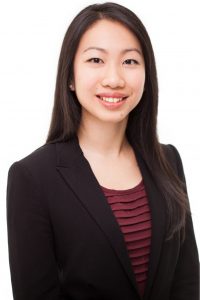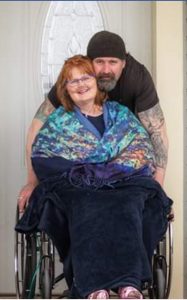Make connections and enjoy September
By Kirk Morrison, Chair, CPFF

As we all know, September is Global Pulmonary Fibrosis Awareness Month. In a year where we can’t get out like we normally do, we thought that it was really important to deliver a program that people can participate in virtually. So we’ve got a great program planned that is fun and informative.
Key activities and events include:
Official kick-off on September 7 where you can blow bubbles virtually with Canadians across the country, anytime during September.
Virtual educational forums across the country that you can attend throughout the month.
Clarke Walk for Pulmonary Fibrosis. Our goal is to walk across Canada collectively as a PF Community.
Fun online quizzes and contests.
Virtual closing ceremonies.
We’ve got a website and an app that facilitates everyone’s participation. Go to www.HopeBreathesHere.com, where you can register for the events, sign up for the Clarke Walk, post pictures and videos and participate in the quizzes and contests.
I can attest to the fact that getting involved has pushed my comfort zone with my digital technology. My advice to everyone who is “wading into the digital pool,” is to stick with it. At the end of the day, although it’s a bit of work, you’ll look back and say “that was easy.” As well, getting familiar with apps and virtual meetings will really be a side benefit for all of us as we move further into the digital world.
Thanks to everyone for their support during the year. Take care, stay safe, and enjoy September!
Kirk Morrison
CPFF Fellow authors article on ILD care during the pandemic and so much more

Respirologist, Dr. Alyson Wong, a recipient of a CPFF Robert Davidson Fellowship from 2018 to 2020, is the lead author of a special feature article published this spring in the prestigious American journal Chest entitled: “Practical Considerations for the Diagnosis and Treatment of Fibrotic Interstitial Lung Disease During the COVID-19 Pandemic.”
The published paper provides practical advice to guide health care professionals in the care of patients with ILD during the COVID-19 pandemic and to provide a road map for clinicians caring for these patients during future infectious disease outbreaks. We encourage you to share the link above and this article with members of your health care team.
Major issues for ILD patients during the pandemic have included restricted access to key components in the diagnostic process, new uncertainties in the use of common ILD medications and a limited ability to monitor and address disease progression and drug side effects, according to Dr. Wong.
The paper outlines possible modifications to the diagnosis and treatment of ILD depending on the community spread of COVID-19:
- Conduct visits with patients by videoconference, have blood tests done during off-peak times or by appointment, and defer pulmonary function tests (PFTs) if possible, given the potential increased risk of generating aerosols that could transmit the virus.
- Multi-disciplinary discussions can take place virtually, rather than in person, with at least an ILD clinician and a chest radiologist involved.
- Bronchoscopy and surgical lung biopsy (SLB) should be deferred for most patients unless critical in making short-term treatment decisions.
- Patients should be re-assessed after the COVID-19 pandemic to determine whether additional tests are required to complete their ILD work-up.
- Immune-suppressing medications are often used to treat ILD. These medications can result in more severe disease in immunocompromised patients. However, such patients do not appear to have an increased risk for, or severity of COVID-19, except that corticosteroids my be harmful in the early stages of infection. It is reasonable to use immune suppressing medications in patients who are not suspected of having COVID-19, preferably limiting the use of corticosteroids.
- Anti-fibrotic medications can be started, although there is overlap between medication side-effects and symptoms of COVID-19 (e.g. diarrhea, fatigue and loss of appetite) which may make it more difficult for early identification of COVID-19. Those already taking anti-fibrotic drugs can usually continue to take them.
- Many provinces require regular testing to continue coverage of medications. Most have extended coverage with modified testing criteria, due to COVID-19 restrictions on health care access.
Patients receiving chronic ILD therapy may be able to decrease monitoring frequency to minimize contact with the health-care system, while ensuring they receive appropriate medical care. For those starting ILD therapy, regular blood work monitoring should still be done to assess for side effects.
The paper also suggests that people living with ILD, like most of the public, practice physical distancing, wash hands frequently and stay as active as possible, while observing public health restrictions. ILD nursing support, where available, can be accessed by phone or email. Along with many surgeries, lung transplants may also be delayed during COVID-19.
The publication also discusses COVID-19 in people with ILD. It is unknown whether patients with ILD have different or more severe manifestations of COVID-19 than those without ILD. “Data suggest that mechanical ventilation in patients with fibrotic ILD and concurrent COVID-19 may not be appropriate, particularly when urgent lung transplantation is not an option or when resources are significantly constrained. Establishing an advanced care directive while patients are stable is exceedingly important to ensure that physicians and family members make decisions that are aligned with patient values.”
“The pandemic has also significantly curtailed research activities,” says Dr. Wong. Research centres in areas with high COVID-19 community spread are no longer opening new clinical trials, while ongoing trials are adapting to ensure patient safety, while attempting to maintain trial integrity. Delays in trials also means reduced research revenue and difficulties retaining key personnel without salary support.
This year, during the pandemic, CPFF has been able to double support for its fellows to fund four clinical researchers thanks to one-time grants from sponsors Boehringer Ingelheim and Hoffmann-La Roche Ltd., as well as ongoing support from individual donors. (See the fellows’ profiles on our website.)
“The CPFF fellowship is critical to improving patient access to ILD specialists in Canada,” says Dr. Wong. “It is the only funding available specifically for ILD training in Canada.”
For Dr. Wong, the fellowship enabled her to engage with ILD patients in clinic as well as in support group meetings and education forums. This month she will make a virtual presentation on September 18th as part of the CPFF’s Pulmonary Fibrosis Awareness Month activities.
At the end of her two-year fellowship in July, Dr. Wong began a full-time academic position as a Clinical Instructor at UBC and joined the ILD program at St. Paul’s Hospital in Vancouver. Her research endeavours as a CPFF fellow also meant she collaborated with most of the ILD specialists in Canada and others abroad.
During her fellowship, she also completed a Master in Health Science and published two other papers: “Progression of fibrosing interstitial lung disease,” in the journal Respiratory Research and “Diagnostic Features in Combined Pulmonary Fibrosis and Emphysema (CPFE): A Systematic Review,” in the Annals of American Thoracic Society Journal.
The first of these research papers is a review article, written by Dr. Wong, Dr. Sabina Guler of Switzerland and Dr. Christopher Ryerson of Vancouver, which summarizes research on the evaluation and management of patients with progressive fibrosing ILDs (PF-ILDs) and discusses questions relevant to applying recent clinical trial findings to real-world practice.
The review concludes that recent clinical trials indicate potential benefit from antifibrotic medication in PF-ILDs beyond idiopathic pulmonary fibrosis. The trials support the utility of subclassifying patients with various fibrotic ILD subtypes based on their anticipated disease behaviour. It is critical to remember that this approach is complementary to establishing a confident clinical diagnosis that also carries important management and prognostic implications.
“The main message from this review, confirms the importance of an accurate diagnosis in determining appropriate treatment,” says Dr. Wong.
The goal of the second article, which Dr. Wong led, summarizes the definition and diagnostic criteria used in previous studies of Combined Pulmonary Fibrosis and Emphysema (CPFE). The review began with an initial search of MEDLINE and EMBASE databases, between January 2000 and 2019, for studies in English, that included at least 10 patients with evidence of both PF and emphysema. After screening an initial result of 11,302 items, the review ultimately included 72 studies.
“Right now there is no formal diagnostic criteria for CPFE and that makes it difficult to define and conduct research,” says Dr. Wong. “We hope that the results of this review will inform the efforts of various thoracic societies when creating CPFE guidelines. These defined criteria will help advance research in this area, and ultimately advance care for people living with this condition.”
In addition to these recent publications, ongoing patient care, and teaching responsibilities, Dr. Wong is also conducting research into the economic impacts of ILD in British Columbia. “This project will take several years, as provincial health data becomes available,” says Dr. Wong.
“I’m incredibly grateful to CPFF, and its donors, for giving me the opportunity to pursue these clinical and academic goals during the two years of my fellowship,” says Dr. Wong. “I believe the fellowships are critical to improving our knowledge of ILD, expanding access to specialist care and conducting research to improve the lives of people living with ILD.”
Jacqui Bowick-Sandor faces life post-transplant with amazing grace

Four years ago, double-lung transplant recipient Jacqui Bowick-Sandor ran a Facebook contest to name her two new lungs. The winner suggested Amazing and Grace. The names could also be used to describe this brave 55-year-old from Smith Falls, Ontario, as she faced life with IPF and then the ongoing challenges following her transplant.
Her journey has not been the miracle cure that many others talk about or experience. She has always struggled, and still does, health-wise, but she has important lessons to share with our pulmonary fibrosis community and is adamant about giving back to others in many ways. You can hear Jacqui talk about her lung transplant in her own words in her 16-minute podcast.
She shares her thoughts and feelings of fear and excitement. The endless complications, including heart issues, a 28-day coma, and re-admission to hospital after catching C-difficile and suffering from hypoxia during rehab. She talks about sobbing for joy when she finally made it back home.
She also shares some humorous moments, like offering six first responders (EMS, police and firefighters) Girl Guide cookies, when they arrived after she had difficulty breathing while at the rehab facility. They offered her oxygen in return and she thought it was a pretty good trade!
For most of her life, Jacqui has lived with less than perfect health. She always had sinus issues and caught every cold. She seemed to be at the doctor all the time. No wonder she pursued careers as an RNA (registered nursing assistant) and as a pharmacy technician. She was always in tune with her body and would dig, dig, dig for information about her health issues.
She was mis-diagnosed three times, as she sought relief from a persistent cough, shortness of breath and fatigue. The first inkling she had of a more serious lung issue, was during a regular pre-operative assessment for an unrelated matter in 2011. The anesthesiologist noticed that she had cupped fingernails, a sign of pulmonary fibrosis, and suggested she be followed up by a respirologist.
In 2012, she finally learned that she had idiopathic pulmonary fibrosis or IPF. “At the same time I was trying to find a new family doctor, since mine had retired. No one would take me when they learned I had IPF. Many of them didn’t know much about the condition. I felt so alone.”
Eventually, she did find a new family physician, who is even now on speed dial on her phone. “My advice is to find the right doctor for you; someone who respects and honours who you are and lets you speak about your feelings without restriction.”
Around the same time, Jacqui met Robert and Heather Davidson during an CPFF awareness event at Queen’s Park. “It was just so wonderful to speak to others who were facing the same challenges that I was. I got more involved in CPFF and attended several advocacy events and did some fundraising too. The support groups were a bit too far away for me, but I did meet people that I could reach out to when I needed support or information.”
Robert also told me about the ILD clinic at Toronto General Hospital and I did some research and got a referral as soon as I could. I still remember what Dr. Shapera at the clinic told me, “Jacqui, from now on you are the CEO of your own health.” I took his advice seriously and did everything I could to learn all I could about the disease and how to manage it.”
Although she eventually had to give up her job, Jacqui kept busy and as active as possible, swimming and preparing to be a transplant candidate. Within a matter of days in November, 2015, she entered a period of acute exacerbation. “One day I was swimming my laps and two days later I could barely get out of bed.”
Her support team of “angels,” helped her raise more than $30,000 from her community of Smith Falls to make the move to Toronto in February 2016 to wait for new lungs. On March 4, 2016 she got the call that lungs had been found for her. “I was excited, scared and grateful to the family making this gift to me.”
Since then, Jacqui has described her journey as one of learning; about the power of friendship, about being vulnerable and about helping others. Today, she has a personal support worker come to help her for an hour each day. She has struggled since being home. “I’m not doing very well, health-wise” she says. She has diverticulitis, continuous urinary tract infections and diabetes. “Sometimes it’s hard to wake up and I am confused and itchy,” she says.
Jacqui does get out a bit, but only for about two hours at a time. She needs five litres of oxygen at rest and 15 litres when active. She still swims once a week. Whenever she feels down, she remembers her Mom telling her to: “Buck up.”
Helping others helps her too. She is excited that her local Mayor Shawn Pankow will proclaim September Pulmonary Fibrosis Awareness Month. And a local group is raffling a cardinal quilt to fundraise for CPFF. She has also been interviewed by local media and wants more people to know about PF and its early symptoms, to avoid the long road to diagnosis. And there is her podcast too.
“I’ve survived this far with the help of a team of angels, a mountain of prayer and the love and kindness of so many others, so this is my time to give back.” Jacqui gives special credit to her husband Bruce, who is her primary caregiver. “I didn’t expect too much frankly. For 31 years he has spent most of his time and energy on his business. But, he has really stepped up and I couldn’t have done it without him. He is my main angel.” Jacqui is planning a future podcast with her husband Bruce.
And Jacqui’s advice to others with PF: “Get a great doctor who understands you; learn all you can about your disease and ask questions; reach out to the PF community through CPFF and other organizations. You are not alone. It can be a difficult journey, but if I can do it, anyone can.”
Larry Bunce is adapting to life with IPF

After 28 years in the air force followed by a career in aerospace, it’s no surprise that Larry Bunce, 71, embraces some nifty gadgets to help him adapt his active lifestyle since his diagnosis with IPF in 2018.
He now has an electric-assist bicycle and a small portable oxygen delivery system in a backpack. His special sunglasses hold the oxygen hose in place at his nose. A pulse ox devise lets him monitor his oxygen level when he’s out riding. When playing tennis, a little finger monitor, like a ring, vibrates when his oxygen levels dip below 88 per cent.
“While I do notice some deterioration, I’ve been able to adapt my lifestyle to still enjoy many of the activities I did before my diagnosis,” says Larry. “And fortunately, I haven’t had any acute exacerbations yet.”
There have been a few hurdles along the way. In December 2017, Larry had pneumonia whose effects lingered well into the spring. His GP arranged for a chest x-ray and CT scan, then referred Larry to respirologist Dr. Onofre Moran-Mendoza in Kingston, where Larry was living at the time. Further testing revealed that he had IPF. In all, it took about a year to be diagnosed.
“The pneumonia really slowed me down to a crawl,” says Larry, “and then mentally it was tough to deal with having this disease.”
He started on Ofev, but had to take a break from the medication to deal with a hiatal hernia. This occurs when your stomach bulges up into your chest through an opening in your diaphragm, the muscle that separates the two areas.
“This was another rough period,” says Larry. “I had a terrible loss of appetite and lost 14 lbs.” This time his family physician referred him to a dietician. Larry now has an app he uses on his tablet to keep track of his diet, making sure he gets 80 grams of protein and 2,000 calories a day.
Larry connected early with CPFF, subscribing to this newsletter and was one of the first members of the Kingston Support Group, which began in September 2019 and now has about 60 members who meet monthly. Of course, during this time of COVID-19, they are meeting virtually using Zoom.
“Being part of the support group is wonderful,” says Larry. “It helps you become an educated patient and find out how other people are dealing with the disease, like coping with drug side effects and other questions that you don’t often get a chance to ask during medical appointments when your head is spinning dealing with tests and other information coming at you.” Larry is now the main contact for the group, since Blaine Jelley, the previous contact had lung transplant surgery last month. (All indications are that he is doing well.)
Larry too is considering a lung transplant. He met by videoconference with Dr. Coleman of the transplant team at Toronto General Hospital and in June he learned he was a candidate for the assessment process. And he’s read through the 170-page transplant patient manual. “There is a lot to consider,” says Larry. This fall he’ll be having some serious discussions with his wife Marilyn and his three children, two living in Toronto and the other residing in Australia. “It’s not an easy route and at the moment I have a fairly good life.” In the meantime, he recently moved to Cobourg, just east of Toronto, to be closer to his children and the transplant centre.
COVID-19 has also put a wrench in many of the family’s plans. Unfortunately, they can no longer fly to Australia, because of the virus and Larry’s oxygen needs. They have been careful, even before the pandemic, about protecting themselves from flus and other viruses, avoiding crowds and others who are sick. “But this has been tough. You don’t know how long you’ll be feeling well enough to do the things you want to do and see the people you want to spend time with,” says Larry. “And now you’re pretty much in limbo.” When flying is once again possible, they hope their daughter in Australia will come to Canada for a visit.
Larry is planning on participating in most of CPFF’s Awareness Month activities this month. “It’s important that we get the word out about the symptoms of PF, so people can be diagnosed and treated earlier.”
And for those who have recently been diagnosed, Larry has this advice: “Become an educated patient. Get involved with CPFF and join a support group if you can. Take some time to adjust to the news and then get out and find out how others are dealing with it. You don’t have to face this alone.”


